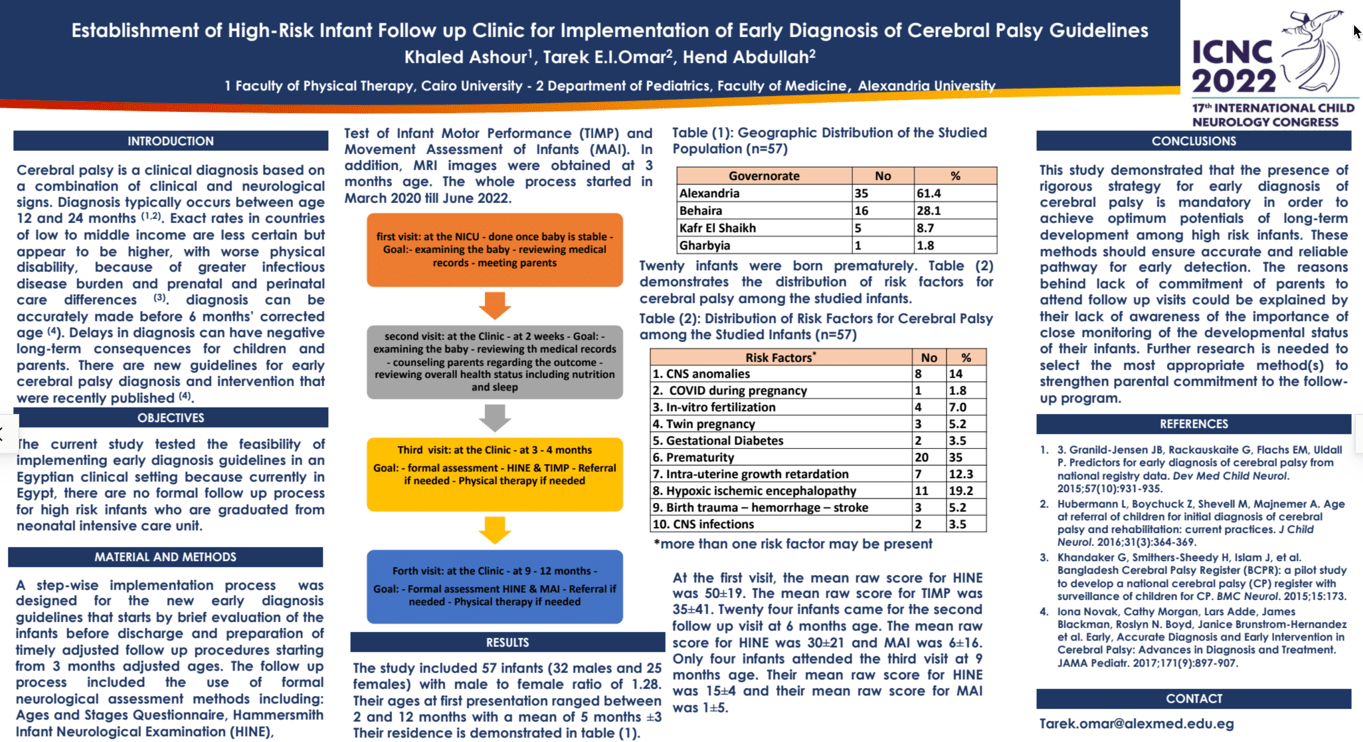Establishment of High-Risk Infant Follow up Clinic for Implementation of Early Diagnosis of Cerebral Palsy Guidelines
Khaled Ashour, tarek omar, Basma ElMohandes
BACKGROUND: Cerebral palsy is the most common physical disability in childhood, and is mostly diagnosed after age 2 years. Delays in diagnosis can have negative long-term consequences for children and parents. There are new guidelines for early cerebral palsy diagnosis and intervention that were recently published. The current study tested the feasibility of implementing these guidelines in an Egyptian clinical setting. Description: Currently in Egypt, there are no formal follow up process for high risk infants who are graduated from neonatal intensive care unit. We designed a step-wise implementation process for the new early diagnosis guidelines that starts by brief evaluation of the infants before discharge and preparation of timely adjusted follow up procedures at 3, 6, 9 and 12 months adjusted ages. The follow up process included the use of formal neurological assessment methods including: Ages and Stages Questionnaire, Hammersmith Infant Neurological Examination, Test of Infant Motor Performance and Movement Assessment of Infants. In addition, MRI images were obtained at 3 months age. The whole process started in March 2020 till now. Results of evaluation will be presented in the poster. Significance: The study represents the first-of-its kind in Egypt as formal follow up process of high-risk infants following their discharge from neonatal units. The use of formal assessment methods that follow evidence based guidelines has proved its impact on the early intervention and outcome of those infants.
Keywords: cerebral palsy - early diagnosis - high risk infants
Khaled Ashour
cairo university
Egypt
tarek omar
Alexandria University
Egypt
Basma ElMohandes
pharoas university in alexandria
Egypt
BACKGROUND: Cerebral palsy is the most common physical disability in childhood, and is mostly diagnosed after age 2 years. Delays in diagnosis can have negative long-term consequences for children and parents. There are new guidelines for early cerebral palsy diagnosis and intervention that were recently published. The current study tested the feasibility of implementing these guidelines in an Egyptian clinical setting. Description: Currently in Egypt, there are no formal follow up process for high risk infants who are graduated from neonatal intensive care unit. We designed a step-wise implementation process for the new early diagnosis guidelines that starts by brief evaluation of the infants before discharge and preparation of timely adjusted follow up procedures at 3, 6, 9 and 12 months adjusted ages. The follow up process included the use of formal neurological assessment methods including: Ages and Stages Questionnaire, Hammersmith Infant Neurological Examination, Test of Infant Motor Performance and Movement Assessment of Infants. In addition, MRI images were obtained at 3 months age. The whole process started in March 2020 till now. Results of evaluation will be presented in the poster. Significance: The study represents the first-of-its kind in Egypt as formal follow up process of high-risk infants following their discharge from neonatal units. The use of formal assessment methods that follow evidence based guidelines has proved its impact on the early intervention and outcome of those infants.
Keywords: cerebral palsy - early diagnosis - high risk infants
Khaled Ashour
cairo university
Egypt
tarek omar
Alexandria University
Egypt
Basma ElMohandes
pharoas university in alexandria
Egypt

Khaled Ashour
Cairo university Egypt
Cairo university Egypt